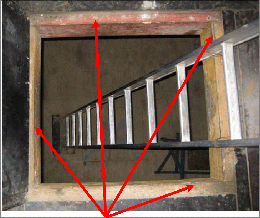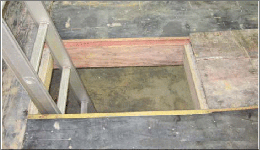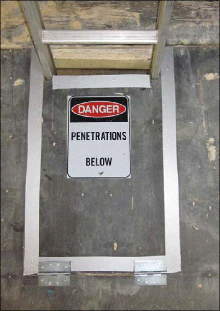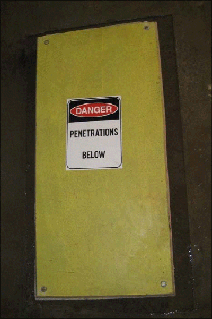Trapdoors and penetration covers in construction
Issued: 20 October 2010
Last Updated: 19 October 2010
Purpose
The purpose of this safety alert is to inform people of the need to correctly design trapdoors and penetration covers and to implement safe systems of work to minimise the risk of falls.
For the purpose of this safety alert a trapdoor means a hinged door on a horizontal surface that can be opened and closed. A penetration cover is any other cover over a penetration.
Background
A worker was injured in an incident when a trapdoor on a jump form platform collapsed and the worker fell through the opening. In other incidents workers have fallen through penetrations when the penetration cover has either collapsed or been pushed out of the way.
Access openings and trapdoors are often constructed to gain access to work areas and for emergency retrieval of workers.
The principles in this safety alert apply to trapdoors or any other cover over a penetration.
Control measures
General planning and design
Penetrations should be minimised as far as practical at the design stage of the structure. This includes penetrations provided for access and those provided as part of the construction activity. Trapdoors and penetrations should be located away from areas where regular access or construction activities are expected.
Trapdoors and penetration covers should be designed by a professional engineer.
All trapdoors and penetration covers should be designed to withstand an equally distributed load equal to or greater than that of the deck on which it is located. In addition the trapdoor or cover should be able to safely withstand a single concentrated load of at least two kilonewtons (this is the same single concentrated load as required for heavy duty scaffolding – see Australian/New Zealand Standard AS/NZS 1576.1 Scaffolding part 1: General requirements for further details).
The designer should avoid locating trapdoors and covers on major access ways or wherever regular pedestrian traffic is expected.
Work systems - trapdoors and covers
Where penetrations exist, work procedures should be implemented to minimise the risk of workers and materials falling through the penetrations. This should include a process that helps workers to be aware of the location of trapdoors and covers. This will reduce the risk of workers tripping on penetration covers or inadvertently jumping on to a trapdoor without knowing they are doing so.
Persons should not jump onto trapdoors or penetration covers.
Trapdoors
Trapdoors are to be constructed so that the trapdoor itself and its support will not fail. Trapdoors need to be able to support persons walking or standing on them.
The following applies to trapdoors:
- The trapdoor itself should be constructed from a single piece of material.
- The material used to construct the trapdoor should be a structurally rated material. For example, if plywood is used to construct the trapdoor the plywood should be of a structural grade to an appropriate design and manufacturing standard such as AS/NZS 2269 Plywood-Structural or AS 6669 Plywood-Formwork.
- The trapdoor should be designed and installed to be supported, when closed, around as much of its edge as practical. For example, support should be provided under all four edges of the trapdoor, except under the area of the trapdoor removed to allow the ladder to pass through the closed trapdoor (see photographs 1 and 2).
- The support under the trapdoor should be by structural bearers and not strips of timber that has been screwed to the formwork deck.
- In order to allow the ladder to protrude through the deck, part of the trapdoor will need to have a section removed. This cut out should be as small as possible, while allowing a ladder angle of 4 to 1. The cut out should not be wider than the outside of the ladder stiles.
- Where a trapdoor is no longer in use it should be locked or fastened so that it cannot be easily opened.
- The hinges on the trapdoor are to be robust and remain serviceable for the life of the trapdoor.
- Trapdoors should be marked with the words 'Danger Hole Under' or, 'Danger Penetrations Below; or similar (see photograph 3).
Photograph 1: Trapdoor opened showing timber support underneath |
Photograph 2: Trapdoor opened side view |
Photograph 3: Trapdoor closed |
Covers over penetrations
The following applies to covers over penetrations:
- In formwork construction a penetration in the floor may be required in the final structure (i.e. for pipes, electrical cables or other services). Where practicable, the penetration should be provided with cast-in mesh when the concrete floor is poured. The mesh can be cut out at a later stage. This will reduce the risk of persons falling down the penetration. The mesh should be 50 millimetres x 50 millimetres or smaller and made from material capable of withstanding the potentially imposed load.
- All penetrations will be provided with a cover secured to the floor or otherwise effectively restrained so that it remains in position
- Fixings for the cover are to be structurally adequate and should require the use of a tool to be removed.
- Fixings are to be an adequate distance from edges to prevent failure of the cover, fixing or supporting surface (information will be available from the fixing manufacturer).
- Covers should be painted in a bright colour and be marked with the words 'Danger Hole Under' or 'Danger Penetrations Below' or similar.
- The cover must never be left with fixings removed.
- If the cover is removed, the penetration should be provided with appropriate edge protection to prevent persons falling through or into the penetration.
Photograph 4: Penetration cover showing sign and fixings at each corner |
More information
Further information is available in the Formwork Code of Practice 2006 available at http://www.worksafe.qld.gov.au or by calling the Workplace Health and Safety Infoline on 1300 369 915.



